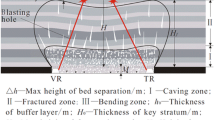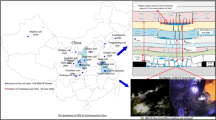Abstract
Bed separation can occur above coal mines when thick, hard roof strata overlie weaker roof strata. The water that accumulates represents a major hazard. We have categorized bed separations and indicators of threatening situations, and analyzed the morphological evolution of bed separation. Technologies exist to identify bed separation water, including its location and the risk it represents, and to calculate the maximum heights of bed and residual bed separations. These technologies were applied to the 1307 working face in the Xinji no. 1 coal mine, in Huainan, Anhui Province. Menacing bed separation was identified in the nappe fault zone. The maximum heights of the bed and residual bed separations were 5.92–6.90 m and 1.97–2.30 m, respectively.
Zusammenfassung
Hangendspaltenbildung kann über Kohlenabbauen auftreten, wenn mächtige, feste Hangendschichten weniger feste Nebengesteine überlagern. Wasseransammlung in den Spalten ist eine große Gefahr. Wir haben Hangendspalten und Indikatoren drohender Zustände kategorisiert und die morphologische Entwicklung der Schichtspaltenbildung analysiert. Es gibt Technologien zur Identifizierung des Schichtspaltenwassers, seiner Lage und des Risikos, und um die maximale Höhe der Hangend- und Liegendschichttrennung zu berechnen. Diese Technologien wurden in dem Streb #1307 der Xinji Nr. 1 Kohlenmine, in Huainan, Anhui Provinz angewendet. Bedrohliche Hangendspaltenbildung wurde in der Deckenstörungszone erkannt. Die größten Spalthöhen zwischen Hangend- und Liegendschicht betrugen 5.92-6.90 m and 1.97-2.30 m.
Resumen
La separación del lecho puede ocurrir en las minas de carbón cuando los estratos gruesos y duros del techo se encuentran sobre los estratos más débiles del techo. Se categorizaron las separaciones de lecho y los indicadores de situaciones potencialmente peligrosas y se analizó la evolución morfológica de la separación del lecho. Existen tecnologías para identificar el agua de separación del lecho, incluyendo su ubicación y el riesgo que representa, y para calcular las alturas máximas de las separaciones de lecho y lecho residual. Estas tecnologías se aplicaron a la cara de trabajo 1307 en la mina de carbón Xinji No. 1, en Huainan, provincia de Anhui. Se identificó la separación potencialmente peligrosa del lecho en la zona de falla de la napa. Las alturas máximas de las separaciones del lecho y del lecho residual fueron de 5,92~6,90 m y 1,97~2,30 m, respectivamente.
煤矿顶板离层的识别与应用
当软弱顶板之上覆盖厚硬顶板时,会形成顶板离层。离层内积聚水能够构成特殊类型水害。对离层及危害指标进行了分类,分析了离层形态的演化。目前离层水识别技术包括离层位置及风险的识别和最大与残余离层高度的计算。该技术已应用于安徽淮南新集矿一矿1307工作面,认为推覆体断层区存在潜在离层危险。最大离层高度和残余离层高度分别是5.92~6.90 m和1.97~2.30 m。





Similar content being viewed by others
References
BMRI (Beijing Mining Research Institute of China Coal Research Institute) (1981) Patterns of surface movement and overlying strata deformation in coal mines and applications. China Coal Industry Publishers, Beijing, pp 55–65 (in Chinese)
Can E, Mekik C, Kuscu S, Akcm H (2013) Monitoring deformations on engineering structures in the Kozlu hard coal basin. Nat Hazards 65(3):2311–2330
Chen SG, Guo H (2008) Numerical simulation of bed separation development and grout injecting into separations. Geotech Geol Eng 26(4):375–385
Chen SG, Hu W (2009) A comprehensive study on subsidence control using COSFLOW. Geotech Geol Eng 27(3):305–314
Coggan J, Gao FQ, Stead D, Elmo D (2012) Numerical modelling of the effects of weak immediate roof lithology on coal mine roadway stability. Int J Coal Geol 90–91:100–109
Diederichs MS, Kaiser PK (1999) Stability of large excavations in laminated hard rock masses: the Youssoir analogue revisited. Int J Rock Mech Min Sci 36:97–117
Gao YF (1996) Four-zone model of rock mass movement and back analysis of dynamic displacement. J China Coal Soc 21(1):51–55 (in Chinese)
Gong WL, Peng YY, Wang H, He MC, Ribeiro e Soysa L, Wang J (2015) Fracture angle analysis of rock burst faulting planes based on true-triaxial experiment. Rock Mech Rock Eng 48(2):1017–1039
Gui HR, Hu YB (1997) Calculation methods of stress analysis for reasonable retainment of water-resisting coal (rock) pillars. China Coal Industry Publishers, Beijing, pp 85–86 (in Chinese)
Gui HR, Lin ML (2016) Types of water hazards in China coal mines and regional characteristics. Nat Hazards 84(2):1501–1512
Gui HR, Reddy DV, Sun LH (2016) A review of technological development in water hazards control in China coal mines. Int J Earth Sci Eng 9(5):1863–1868
Guo GL, Miao XX, Zhang ZN (2002) Research on ruptured rock mass deformation characteristics of longwall goafs. Sci Technol Eng 2(5):44–47 (in Chinese)
Guo WJ, Li YY, Yin DW, Zhang SC, Sun X (2016) Mechanisms of rock burst in hard and thick upper strata and rock-burst controlling technology. Arab J Geosci 9(10):1–11
Heddlewhite BK, Lu T (2004) Geomechanical behaviour of laminated, weak coal mine roof strata and the implications for a ground reinforcement strategy. Int J Rock Mech Min Sci 41:147–157
Ilgner HJ (2000) The benefits of ash filling in South African coal mines. In: coal–the future, 12th international conf on coal research. Proc, South African Institute of Mining and Metallurgy, Johannesburg, pp 279–288
Li P (2016) Groundwater quality in western China: challenges and paths forward for groundwater quality research in western China. Expos Health 8(3):305–310
Li WP, Li XQ, Sun RH (2008) Preliminary study on dynamic water inrush of coal mining under super-thick dead rock. J Eng Geol 16(Suppl 1):446–450
Li P, Qian H, Wu J, Zhang Y, Zhang HB (2013) Major ion chemistry of shallow groundwater in the Dongsheng coalfield, Ordos Basin, China. Mine Water Environ 32(3):195–206
Li P, Qian H, Wu J (2014) Origin and assessment of groundwater pollution and associated health risk: a case study in an industrial park, northwest China. Environ Geochem Health 36(4):693–712
Li P, Qian H, Howard KWF, Wu J (2015) Building a new and sustainable “Silk Road economic belt”. Environ Earth Sci 74(10):7267–7270
Li P, Li X, Meng X, Li M, Zhang Y (2016) Appraising groundwater quality and health risks from contamination in a semiarid region of northwest China. Expos Health 8(3):361–379
Liu GL, Fan KG, Xiao TQ (2012) Study on mountainous shallow-buried coal seam mining working face strata behaviors and overlying strata movement features. Appl Mech Mater 121–126:2911–2916
Majcherczyk T, Małkowski P, Niedbalski Z (2005) Separation of roof rock observed in headings under development. In: proc, 6th international mining forum, underground mining: new technologies, safety and sustainable development, Cracow-Szczyrk-Wieli-czka: A. A. Balkema, pp 53–62
Miao X, Cui X, Wang J, Xu J (2011) The height of fractured water conducting zone in undermined rock strata. Eng Geol 120(1–4):32–39
Palchik V (2003) Formation of fractured zones in overburden due to long wall mining. Environ Geol 44(1):28–38
Palchik V (2005) Localization of mining-induced horizontal fractures along rock layer interfaces in overburden: field measurements and prediction. Environ Geol 48(1):68–80
Palei SK, Das SK (2008) Sensitivity analysis of support safety factor for predicting the effects of contributing parameters on roof falls in underground coal mines. Int J Coal Geol 75:241–247
Qian MG, Xu JL, Miao XX (2003) Green technique in coal mining. J Chin Univ Min Technol 32(4):343–347 (in Chinese)
Qiao W, Huang Y, Yuan ZB (2014) Formation and prevention of water inrush from roof bed separation with full-mechanized caving mining of ultra-thick coal seam. Chin J Rock Eng 33(10):2076–2084 (in Chinese)
Sofianos AJ (1996) Analysis and design of an underground hard rock Vpussoir beam roof. Int J Rock Mech Min Sci 33:153–166
Tan YL, Yu FH, Chen L (2013) A new approach for predicting bedding separation of roof strata in underground coal mines. Int J Rock Mech Min Sci 61:183–188
Vervoort A, Bruce J, Fred J, Gary P (1992) Detailed underground measurement of roof deflection and bed separation. In: proc, 11th international conf on ground control in mining, Australasian Institute of Mining and Metallurgy, pp 352–358
Wang ZM, Wang JM (2008) Prevention and control of the separation water hazard mining beneath nappe of the Xinji mining area. Energy Technol Manag (3):55–57 (in Chinese)
Wu J, Sun Z (2016) Evaluation of shallow groundwater contamination and associated human health risk in an alluvial plain impacted by agricultural and industrial activities, mid-west China. Expos Health 8(3):311–329
Xie XX, Gao YF (2002) Bed separation volume algorithm based on numerical computation of mining overburden rock mass. Chin J Geol Hazard Control 13(3):48–54 (in Chinese)
Xu JL, Qian MG, Jin HW (2004) Study and application of bed separation distribution and development in the process of strata movement. Chin J Geotech Eng 24(5):632–636 (in Chinese)
Xu JL, Wang XZ, Liu WT, Wang ZG (2009) Effects of primary key stratum location on height of water flowing fracture zone. Chin J Rock Mech Eng 28(2):380–386 (in Chinese)
Xu ML, Zhu XG, Zhao DH (2013) Study on surface subsidence and separation range thick seam mining of Daping mine. Adv Mater Res 742:268–271
Xuan DY, Xu JL (2014) Grout injection into bed separation to control surface subsidence during longwall mining under villages: case study of Liudian coal mine, China. Nat Hazards 73(2):883–906
Xuan DY, Xu JL, Wang BL, Teng H (2015) Borehole investigation of the effectiveness of grout injection technology on coal mine subsidence control. Rock Mech Rock Eng 48(6):2435–2445
Yan H, He FL, Yang T, Li LY, Zhang SB, Zhang JX (2016) The mechanism of bedding separation in roof strata overlying a roadway within a thick coal seam: a case study the Pingshuo coalfield, China. Eng Fail Anal 62:75–92
Yang L, Yu GM, Wang XC, Tian R, Li LH (1997) Calculation of position of separated strata due to mining in coal mine. J Chin Coal Soc 22(5):477–480 (in Chinese)
Zhang JQ, Liao GH (2001) Study of the mechanism and the calculation methods about bed separation in overlying strata. Undergr Space 21(5):407–411 (in Chinese)
Zhang DZ, Deng KZ, Zhou M (1998) Research of the hulking coefficient variation law of rock mass caused by mining. Jiangsu Coal (1):5–7 (in Chinese)
Acknowledgements
This work was funded by the National Natural Science Foundation of China (41373095), the Research Project of Wanbei Coal-electricity Group Co. Ltd (2017), the University Natural Science Research Project of Anhui Province (KJ2017A445), and the Practical and Innovative Project of Coal Geology Bureau of Shanxi Province (2017).
Author information
Authors and Affiliations
Corresponding author
Rights and permissions
About this article
Cite this article
Gui, H., Lin, M. & Song, X. Identification and Application of Roof Bed Separation (Water) in Coal Mines. Mine Water Environ 37, 376–384 (2018). https://doi.org/10.1007/s10230-018-0518-0
Received:
Accepted:
Published:
Issue Date:
DOI: https://doi.org/10.1007/s10230-018-0518-0




